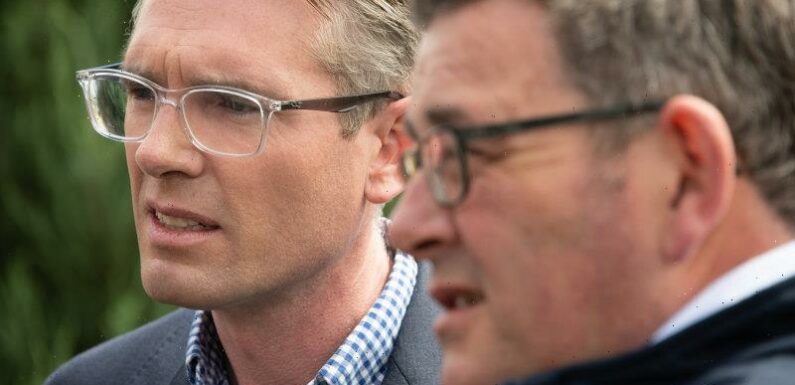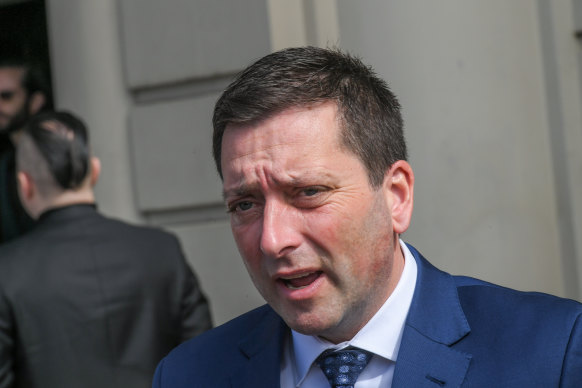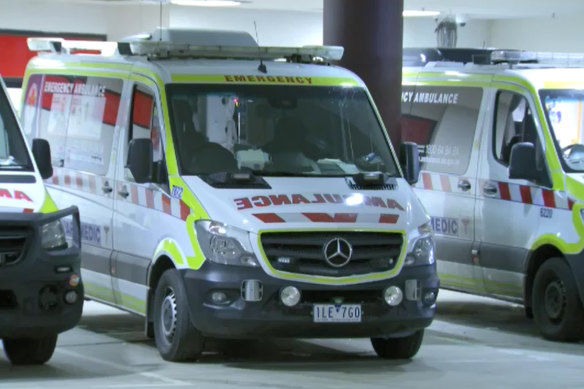
One of the great flash points of the otherwise dull Victorian election campaign came in late October when NSW Liberal premier Dominic Perrottet appeared alongside Labor leader Daniel Andrews.
Perrottet was already on the nose with Victorian Liberals after he earlier dismissed the state Coalition’s entire election pitch: that the crisis in the state’s hospitals was one of Andrews’ own making.
Victorian Premier Daniel Andrews and NSW Premier Dominic Perrottet at Albury last year.Credit:Jules Boag
“They’re not … every state health system around the country and around the world is under pressure,” Perrottet said in August.
But the October announcement in Albury, one month out from the state poll, still came as a shock to the Victorian Liberals, who were reportedly furious they were kept in the dark, and made their displeasure known.
According to those in the know, Perrottet – who didn’t have much confidence in a Coalition victory – was reportedly unperturbed.
Now, with two months until the NSW state election, it’s the Victorian premier who will need to balance competing allegiances delicately as he walks the tightrope between the federal and state health fight.
Victorian Liberals under Matthew Guy were angry they weren’t told about the Andrews-Perrottet announcement on Albury Hospital.Credit:Justin McManus
There was a time when Australian politics was reliably idle from Melbourne Cup Day to Australia Day.
But one week into 2023, and the re-elected Andrews has joined forces with the NSW premier to lobby the federal government to do something meaningful about the health crisis.
They may be on the opposite side of the political aisle, but this is an orchestrated assault.
Andrews may have won the election but he did so despite the health crisis engulfing the state. Victorian hospitals are still struggling to treat patients in emergency and the state's ambulance service is failing to keep up with demand.
Healthcare is a problem for the NSW government, just as it was for the Andrews government before the Victorian election.Credit:Nine News
North of the Murray, Perrottet – who will face voters in March – is also dealing with overcrowding in emergency departments and is looking for a federal fix.
According to insiders from both camps, Dom and Dan will be ramping up their lobbying efforts throughout January ahead of the first national cabinet meeting, scheduled for early February.
But national cabinet is somewhat of a cover. They know they don’t really need the buy-in of the other states. Together, they represent 57 per cent of the national population, so their coalition is a powerful one. As one optimistic insider said: “If we act together, Albo will be forced into doing something.”
Andrews has consistently called for more health funding after the COVID-related 50-50 health funding split with state and territory governments expired at the end of 2022. But it appears that the wishlist has grown a little longer.
In the coming weeks expect to see both premiers at pains to highlight the federal factors contributing to the backlog in emergency departments.
Perrottet has already highlighted the fact that each year, more than 1.5 million people are presenting to NSW emergency departments with non-urgent problems such as migraines and sprained ankles which, for those patients lucky enough to find an appointment, should be treated by GPs.
In Victoria, data indicates that 38 per cent of patients presenting to emergency departments in the past year were either categorised as triage four or five issues such as earaches, rashes or minor aches and pains.
To fix this, Victoria and NSW want incentives for GPs to provide longer consultations, extend their operating hours and broaden bulk-billing services. They will also push the federal government to free up spots in aged care facilities and residential facilities to allow elderly patients or NDIS participants to be discharged from hospital sooner.
But that’s unlikely to be the end of it.
To end the blame game, the two leaders need to prove that this isn’t a problem of their own making. For decades, state and federal health ministers have released contrasting health statistics proving exactly this.
Recently, premiers have been privately seething about some figures being pushed by the federal government and are considering lobbying for an inquiry into the growing number of medical clinics refusing to bulk-bill, the decline in the number of doctors in rural areas, as well as Medicare rebates. They hope it will give them cover by proving once and for all that these issues can only be fixed by more money from Canberra.
While Andrews and Perrottet remain in lock step about the need for the feds to help, the upcoming NSW election will present a strategic challenge for the Victorian leader.
NSW is one of the last remaining Liberal states, but Labor remains confident about its chances of winning government in March. For months, NSW Labor leader Chris Minns has tried to frame the crisis in the state’s hospitals as one caused by the Perrottet government, just as the Coalition gallantly tried to do in the lead-up to the Victorian state election in November.
To achieve real reform, Andrews must stick to the line that this is a federal problem which requires money from the Albanese government. But he will be under pressure to do so without derailing the NSW Labor campaign.
Then there are his federal friends to consider.
Before May’s federal election, Andrews vowed to confront the poll winner to demand a 50-50 funding split for hospitals. “No matter who wins the federal election, these issues are not going away,” he said at the time.
While his commitment to reform remains unchanged, going cap in hand to his factional ally, and one-time housemate Anthony Albanese, is much harder.
Annika Smethurst is state political editor.
The Morning Edition newsletter is our guide to the day’s most important and interesting stories, analysis and insights. Sign up here.
Most Viewed in Politics
From our partners
Source: Read Full Article


